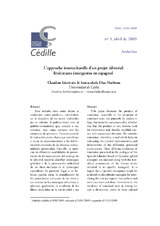Mostrar el registro sencillo del ítem
L’approche interculturelle d’un projet éditorial: littératures émergentes en espagnol
| dc.contributor.author | Lécrivain, Claudine | |
| dc.contributor.author | Díaz Narbona, Inmaculada | |
| dc.date.accessioned | 2018-10-18T11:34:41Z | |
| dc.date.available | 2018-10-18T11:34:41Z | |
| dc.date.issued | 2009 | |
| dc.identifier.issn | 1699-4949 | |
| dc.identifier.uri | http://hdl.handle.net/10396/17343 | |
| dc.description.abstract | Este artículo tiene como objeto la traducción como producto, centrándose en la recepción de los textos traducidos no en relación al público-lector sino al público-consumidor que, compre o no, consulta, ojea, toma contacto con los elementos del paratexto. Partimos pues de la traducción como objeto que contribuye a situar las representaciones y las delimitaciones culturales de las distintas «comunidades » presentadas. Para ello, se analizan las diferentes modalidades de presentación de las traducciones del catálogo de la editorial española Zanzíbar (estrategias globales) y de la presentación individual de las obras incluidas en él (estrategias específicas). Se pretende llegar a un balance, parcial, sobre la identificación de las pertenencias culturales de las obras y sus autores en las estrategias editoriales, y plantear, igualmente, la incidencia de los libros traducidos en la continuidad o no de una visión dicotómica de dichas pertenencias culturales. | es_ES |
| dc.description.abstract | This paper discusses the product of translation, especially in the reception of translated texts, not primarily by readers at large, but more by consumers who, whether they buy the product or not, browse, look for information and, thereby, establish contact with paratextual elements. We consider translation, therefore, a tool which helps in resituating the cultural representations and delimitations of the differently presented communities. Thus, different modalities of translation presented in the catalogue of the Spanish Editorial Board of Zanzibar (global strategies) are analysed along with the individual presentation of the literary works included in it (specific strategies). It is hoped that a (partial) description might be achieved on the editorial strategies for identifying the cultural aspects that authors and texts may have and show. Furthermore, the incidence of translated texts in erasing (or not) a dichotomic vision of these cultural aspects will be also considered. | es_ES |
| dc.format.mimetype | application/pdf | es_ES |
| dc.language.iso | fra | es_ES |
| dc.publisher | UCOPress | es_ES |
| dc.rights | https://creativecommons.org/licenses/by/4.0/ | es_ES |
| dc.source | Çédille 5, 198-214 (2009) | es_ES |
| dc.subject | Traducción | es_ES |
| dc.subject | Recepción | es_ES |
| dc.subject | Identidad | es_ES |
| dc.subject | Representaciones culturales | es_ES |
| dc.subject | Mercado editorial | es_ES |
| dc.subject | Editorial Zanzíbar | es_ES |
| dc.subject | Translation | es_ES |
| dc.subject | Reception | es_ES |
| dc.subject | Identity | es_ES |
| dc.subject | Representations cultures | es_ES |
| dc.subject | Zanzibar Editorial Board | es_ES |
| dc.title | L’approche interculturelle d’un projet éditorial: littératures émergentes en espagnol | es_ES |
| dc.type | info:eu-repo/semantics/article | es_ES |
| dc.relation.publisherversion | http://www.uco.es/ucopress/ojs/index.php/ced | es_ES |
| dc.rights.accessRights | info:eu-repo/semantics/openAccess | es_ES |

